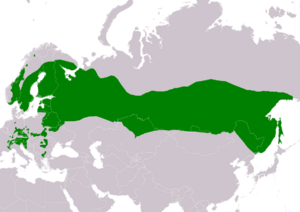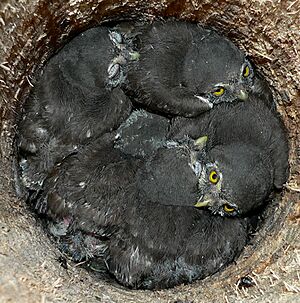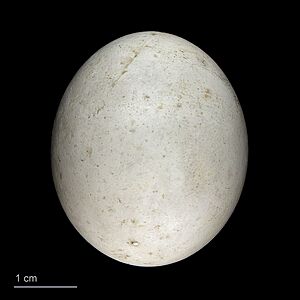Eurasian pygmy owl facts for kids
Quick facts for kids Eurasian pygmy owl |
|
|---|---|
 |
|
| Conservation status | |
| Scientific classification | |
| Genus: |
Glaucidium
|
| Species: |
passerinum
|
 |
|
| Range of G. passerinum Resident | |
| Synonyms | |
|
Strix passerina Linnaeus, 1758 |
|
The Eurasian pygmy owl (Glaucidium passerinum) is the smallest owl found in Europe. It's a small, quick owl with reddish-brown or greyish-brown feathers. You can spot it by the white spots on its sides and a half-ring of white feathers on the back of its neck. These tiny owls live in the cool, northern boreal forests, stretching from Central Europe all the way to Siberia.
These owls usually stay in the same area all year round. They are called "sedentary" because they don't migrate far. However, if winter gets really tough, some adults might fly a bit further south to find food. Young owls often move to new areas in the autumn or winter.
Contents
About the Eurasian Pygmy Owl
Scientists like to give every living thing a special name, just like we have first and last names. This helps everyone around the world know exactly which animal or plant they are talking about. This system is called binomial nomenclature.
The Eurasian pygmy owl was first officially described by a Swedish scientist named Carl Linnaeus in 1758. He gave it the name Strix passerina. Later, another scientist, Friedrich Boie, put this owl into a different group, or genus, called Glaucidium. The name passerinus comes from Latin and means "sparrow-like," because this owl is about the size of a sparrow!
Different Types of Pygmy Owls
There are two main types, or subspecies, of the Eurasian pygmy owl:
- G. p. passerinum: This type lives in central and northern Europe, extending to southwest Siberia. It was named by Linnaeus in 1758.
- G. p. orientale: This type is found in central and eastern Siberia, Mongolia, and northeast China. It was named by Władysław Taczanowski in 1891.
What Does the Pygmy Owl Look Like?
The Eurasian pygmy owl usually has feathers that are reddish-brown or greyish-brown, with small dots on its back. Its tail is a bit darker than its body and has five thin, whitish stripes. It has a small, round head with white or grey eyebrows and bright yellow eyes. Unlike many other owls, it doesn't have ear tufts (those feather tufts that look like ears).
You can see a white half-collar on the back of its neck. Its belly is mostly white with brown speckles. The beak is a greyish-yellow and shaped like a hook.
Size and Weight
To help it carry bigger animals it catches, this owl has surprisingly large feet for its size. Its legs and toes are brownish-yellow with sharp black talons. Female owls are usually a bit bigger than males. Females are about 17.4 to 19 centimeters (6.8 to 7.5 inches) long. Males are generally smaller, measuring about 15.2 to 17 centimeters (6 to 6.7 inches) in length.
When it comes to weight, females are about 67 to 77 grams (2.4 to 2.7 ounces). Males are a bit lighter, weighing about 50 to 65 grams (1.8 to 2.3 ounces).
How the Pygmy Owl Sounds
The call of the Eurasian pygmy owl is much higher pitched than the typical "hoot" you might expect from an owl. The male owl makes a steady chain of clear, flute-like notes, with about two seconds between each note. The female's call is similar but has a higher pitch. Before and after the time they mate, both males and females make a series of five to seven notes that rise in pitch.
Where Do Pygmy Owls Live?
You can mostly find this owl in coniferous forests, which are forests with trees like pines and firs. It also lives in higher mountain areas that have both coniferous and mixed forests. These places usually have cooler temperatures and more rain than nearby lower areas.
The owl often lives along the edges of clearings, especially if there's moist or swampy land nearby and a water source. It likes to make its home in old holes made by woodpeckers, often those created by the great spotted woodpecker.
Pygmy Owl Behaviour
This owl is crepuscular, which means it is most active during the hours around sunrise and sunset. It's not strictly nocturnal (active only at night) like some other owls.
Reproduction and Life Cycle
Eurasian pygmy owls build their nests in tree cavities, which are often old holes made by woodpeckers. While they prefer conifer trees, they will also use holes in birch and beech trees. Pairs of owls form in the autumn and stay together until early spring.
During courtship, the male owl guides the female through his territory. If he has found a good nest hole, he will lead her to it. The male will also bring food to the female. These owls are serially monogamous, meaning they stay together as a pair for one or more breeding seasons. The male protects his territory and might use the same nesting spot for up to seven years.
The female usually lays about four to seven eggs, typically in April. She sits on the eggs to keep them warm for about four weeks, starting when the third egg is laid. The chicks hatch almost at the same time. The female stays with the young owls for about nine to ten days, and the male brings food to her and the chicks.
After three weeks, the young owls become more active. The female then only returns to the nest to feed them and clean out any waste. The young owls are ready to fledge (leave the nest and fly) when they are 30 to 34 days old. They stay close to the nest for a few days before flying off on their own.
What Do Pygmy Owls Eat?
The Eurasian pygmy owl's diet mainly includes small mammals like voles, lemmings, bats, and mice. They also eat small birds such as thrushes, crossbills, chaffinches, and leaf-warblers. They are skilled hunters and can even catch birds while they are flying! Sometimes, they also eat lizards, fish, and insects.
Pygmy owls are known for storing food. In the autumn, they collect large amounts of small mammals and birds. They keep these food stores to help them get through the winter when food might be harder to find. Their habit of hoarding food is greatly affected by the weather.




